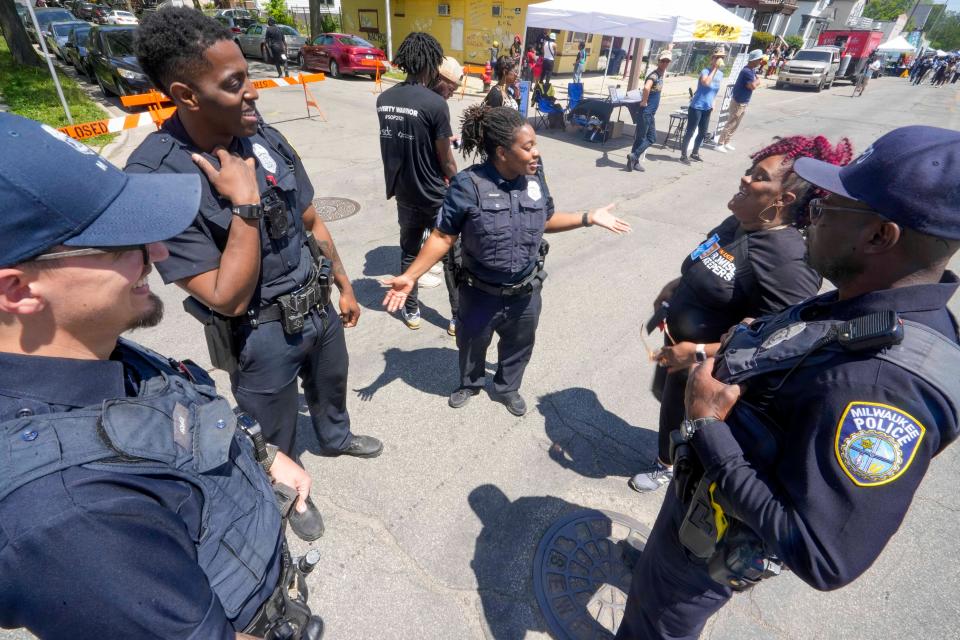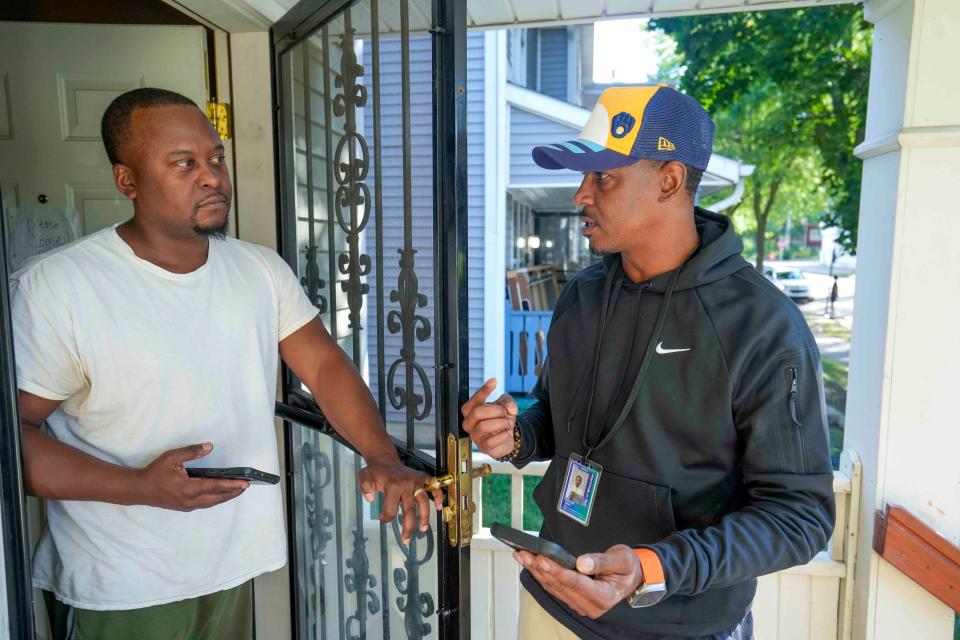Gun violence in Milwaukee trended down in 2023. But there's still too much of it.

After three consecutive years of record-breaking homicides and nonfatal shootings in Milwaukee, both crimes finally declined in 2023.
Although anyone who is involved in violence prevention, policing or public health will quickly tell you the task of lowering the city’s gun violence remains a towering challenge — gun crimes are still roughly double that of pre-pandemic levels — there is still some growing confidence among those at the frontline of the issue.
“We’re seeing some positive trends we haven’t seen in the last couple years,” said Constance Kostelac, the director of Milwaukee’s Homicide Review Commission and a professor at the Medical College of Wisconsin. “Certainly nowhere near where we want to see in terms of the levels, but at least (it's) a positive direction overall, so that’s encouraging and something we certainly want to see continue in 2024.”
As of Tuesday, the city recorded a preliminary total of 173 homicides in 2023, according to the Milwaukee Police Department and the Milwaukee County Sheriff’s Office. That number is about a 20% drop from the 215 recorded in 2022.
It's the largest single-year drop since 2008, when homicides fell 32%, according to FBI data.
The 2023 numbers are still preliminary, as death investigations continue. Incidents that were initially reported as a homicide may later be determined to be self-defense, for example, causing the number to fluctuate into the new year.
The size of the remaining issue is easily apparent. Apart from the still-large number of homicides — 173 tops the city’s pre-pandemic record of 165, set in 1991 during the crack epidemic — Milwaukee did not see as big a drop in nonfatal shootings — 5%.
Milwaukee mirrors national trends

The numbers from this year align Milwaukee more closely with national trends. Although national homicide numbers are still comfortably higher than they were in 2019, preliminary findings from AH Datalytics, which studies national crime trends, estimate a 12% decline in more than 170 American cities in 2023.
That would be one of the biggest single-year drops ever recorded.
Meanwhile, gun assaults — a term that is broader than nonfatal shootings — dropped 5.6% in the fist half of 2023, according to the Council on Criminal Justice.
Experts suggested homicides and shootings are declining nationally because the effects of pandemic disruptions and the damaged police-community relations from the murder of George Floyd are lifting. But increased gun-carrying, brought on by historic levels of firearm purchases during the pandemic, continue to play a role in elevated levels of gun violence.
“The last three years in our lives were aberrations in a way,” said Alex Piquero, a professor of sociology and criminology at the University of Miami. “We’re starting to see some of those pressures that were occurring in 2020 and 2021 kind of abate at the national, aggregate level.”
Signs of progress in Milwaukee

Locally, officials are less eager to theorize about the declines in Wisconsin’s largest city.
However, they are unanimous in that targeted enforcement from police; the rollout, albeit slowly, of $12.65 million in federal pandemic aid for violence prevention; increased programming for minors; expanded domestic violence services and unprecedented levels of collaboration between law enforcement, community groups, public health experts and other public entities have helped save lives.
“I believe that we are in a better position of collaboration than we ever have been before,” said Police Chief Jeffrey Norman. “We have made gains, but we still have a lot of work to do. You can never be comfortable with where we’re at. One shooting and one homicide is one too many.”
Still there are more resources needed. Officials in Milwaukee have called for continued investment in affordable housing, mental health and substance use treatment and services, employment and youth activities. And they have called on state and federal lawmakers to enact universal background checks and extreme risk protection orders, which are supported by a majority of Wisconsinites but have been blocked a Republican-controlled Legislature.
There are longstanding trends in Milwaukee’s gun violence that persisted into 2023. In a city that has suffered from generations of racial segregation, poverty, neglect and easy access to firearms, victims (86%) and suspects (88%) of homicides and nonfatal shootings are overwhelmingly Black.
Milwaukee’s north, northwest and, to a lesser extent, near-south sides, continue to bear the brunt of the city's violence.
However, Reggie Moore, the director of community safety policy and engagement at the Medical College of Wisconsin, said 2023 was the first year he could remember where homicides decreased in all seven of Milwaukee’s police districts. Three saw increases in nonfatal shootings.
Where officials report some progress is in child and domestic violence-related homicides.
Although children are still being shot and killed at twice the rate of pre-pandemic years, child homicides dropped from 27 to 21 in 2023, as of Dec. 21. Moore said efforts to mediate conflicts among youth, which can spill over into gun violence, have “been extremely productive over the past year.”
Meanwhile, domestic violence-related homicides across all of Milwaukee County dropped from 41 to 31 as of Dec. 19, according to the Sojourner Family Peace Center, the largest service provider for domestic violence victims in Wisconsin.
Carmen Pitre, the president of the organization, attributed that to expanded intervention services as a result of a $1 million grant from the state government.
She said she expects the additional resources will “further reduce the homicide rate in the years to come.” But like other officials, she is mindful of the substantial challenges that remain.
“Why I’m cautious is because I think we still have too many people living in despair and hopelessness,” she said. “And in despair and hopelessness, people adapt sometimes by using violence because they’ve learned it. We’re not done with dealing with the impact that violence has on peoples’ lives and how kids grow into that.”
How to find help
Where to find free gun locks
United Neighborhood Center of Milwaukee, 1609 W. North Avenue.
City on a Hill, 2224 W. Kilbourn Avenue, during outreach events on the second Saturday of each month.
Milwaukee Christian Center, 807 S. 14th Street, at their food pantry, which operates Monday through Thursday, from 1 to 3 p.m.
Neighborhood House of Milwaukee, 2819 W. Richardson Place.
Neu-Life Community Development, 2014 W. North Avenue.
Silver Spring Neighborhood Center, 5460 N 64th Street.
COA Youth and Family Centers, 909 E. Garfield Ave. and 2320 W. Burleigh St.
Northcott Neighborhood House, 2460 N. 6th St.
Journey House, 2110 W. Scott St.
All Milwaukee Fire Department stations and health centers run by the Milwaukee Health Department also hand out free gun locks. Directories for fire stations and health centers are available online.
Domestic violence
The National Domestic Violence Hotline is 800-799-7233.
The Sojourner Family Peace Center in Milwaukee operates a 24-hour confidential hotline at 414-933-2722.
We Are Here Milwaukee provides information on culturally specific organizations at weareheremke.org.
The Women’s Center in Waukesha has a 24-hour hotline at 262-542-3828.
The Asha Project, which provides culturally specific services for African American women and others in Milwaukee, provides a crisis line from 9 a.m. to 4 p.m. at 414-252-0075.
The UMOS Latina Resource Center in Milwaukee offers bilingual, bicultural domestic violence, sexual assault and anti-human trafficking supportive services and operates a 24-hour hotline at 414-389-6510.
The Gerald L. Ignace Indian Health Center offers culturally sensitive, trauma-informed services for those who have experienced domestic or sexual violence and can be reached at 414-383-9526.
Our Peaceful Home, which serves Muslim families and is a program of the Milwaukee Muslim Women’s Coalition, operates a crisis line at 414-727-1090.
The Hmong American Women’s Association, which serves the Hmong and Southeast Asian community, has advocates available at 414-930-9352 from 8 a.m. to 4:30 p.m. Monday through Friday.
End Domestic Abuse Wisconsin has a statewide directory of resources at endabusewi.org/get-help.
Conflict mediation and crisis support
414Life outreach and conflict mediation support: 414-439-5398.
Milwaukee County's 24-Hour Mental Health Crisis Line: 414-257-7222.
Milwaukee's Child Mobile Crisis and Trauma Response Team: 414-257-7621.
National crisis text line: text HOPELINE to 741741 to text with a trained crisis counselor.
National Suicide Prevention Hotline: Call or text 988 or chat at 988lifeline.org.
Contact Elliot Hughes at elliot.hughes@jrn.com or 414-704-8958. Follow him on X at @elliothughes12.
This article originally appeared on Milwaukee Journal Sentinel: Milwaukee gun violence trended down in 2023 for first time since 2019

